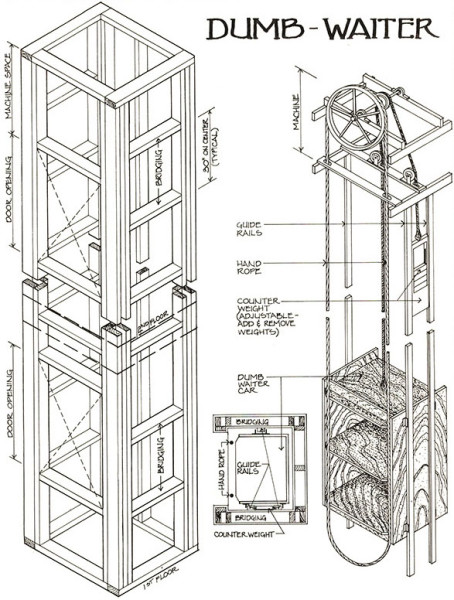
Dumbwaiters were in use as early as the beginning of the 19th century—and probably earlier. (Illustration: Old House Journal Archive)
The owners of the 1890 house in Peoria restored the existing manual dumbwaiter, which travels up and down three storeys. A dumbwaiter—a little elevator that’s basically a box or a tray run by ropes and pulleys—is useful for bringing groceries to an upstairs kitchen, moving laundry from bedroom to basement, and hauling suitcases down from the attic.
With the box and ropes removed, old dumbwaiter shafts often were used for retrofitted plumbing, electrical, or HVAC lines. Some old dumbwaiters have been boarded up, some turned into closet space, and these may be relatively easy to restore: if the pulley mechanism remains, it may need only new ropes. A dumbwaiter consists of a car enclosed in a shaft and suspended by ropes or chains from a pulley or pulleys above, so that it may be raised or lowered by means of a hand rope. The car is counterbalanced by adjustable iron weights (similar to the sashes in a double-hung window). The extra weight of a load in the car is offset by friction in the pulleys, or is resisted by some sort of locking mechanism or brake. Often there is a lock in the front bearing of the main shaft so that the car is always locked except when the rope is pulled.
Dumbwaiters (and light elevators) meant for multi-storey buildings usually were provided with a brake for the hand wheel. A check rope is attached to the brake lever, which allows the operator to regulate the speed of the car when descending. The counterweight is adjusted so that the car will descend when the brake is released.
The car is steadied in its movement up and down by guide rails that are fixed to the shaft framing. These are wood in old models, metal today. The entire assembly of pulleys, gearing, car, ropes, rails, counterweights, etc., might have been bought as a package from the manufacturer and assembled on site. The builder could buy just the hoisting machinery and have a local carpenter fashion the car and wood guide rails, and install the ropes.
A hand-operated dumbwaiter is a relatively simple mechanism. Assuming all of the pulleys are still in place, two major problems are likely to occur: (1) ropes stretch or break; (2) guide rails are now out of alignment. Problems with wooden guide rails can be quite troublesome. The reason that the installation specs call for bridging every 30″ is to provide firm anchorage for the guide rails. However, if the house framing itself has shifted or settled, then obviously the bridging will have moved. In many cases, it’s possible to undo and re-align the guide strips. Some cars had a guide adjustment at the top of the car, to address minor alignment problems. If you replace the car, you’ll have to adjust the counterweight.
Manual Sources
The car is suspended by ropes or chains from a pulley or pulleys above, so that it may be raised or lowered by means of a hand rope.
Silent Servantsilentservant.com Dumbwaiters for residential and commercial use by Miller Manufacturing, using metal guide rails.
Whitco/Vincent Whitney Co.vincentwhitney.com Specializing in hand-operated dumbwaiters, residential and commercial, with capacities from 65 to 250 lbs.







